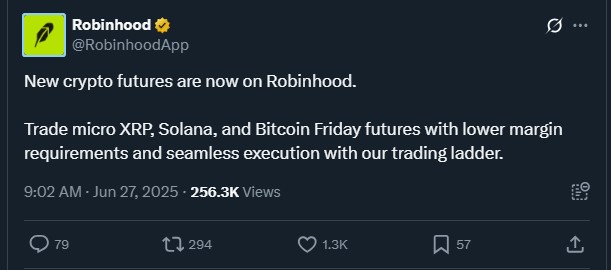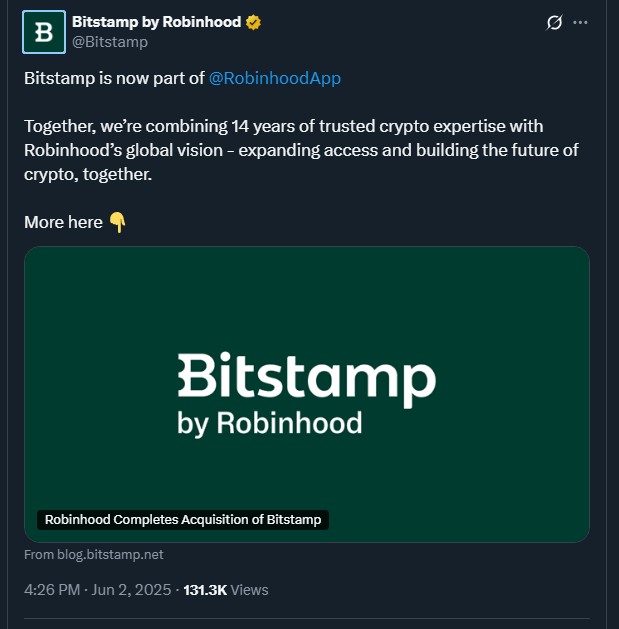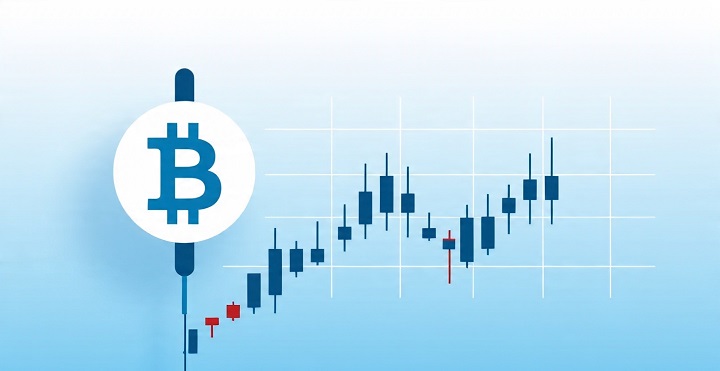In May 2025 alone, Robinhood saw a dramatic $11.7 billion in crypto trading volume. Now, it’s doubling down with a move that could give smaller investors a fresh way into crypto futures.
The online brokerage giant has launched micro futures contracts for Bitcoin (BTC), Solana (SOL), and XRP, expanding its crypto derivatives suite for nearly 26 million funded accounts. But what does this mean for regular traders—and the broader crypto ecosystem?
1. How Robinhood’s Micro Bitcoin, Solana, and XRP Futures Work for Retail Traders

Micro futures contracts let traders speculate on the future price of cryptocurrencies using a fraction of the capital normally required. Unlike standard futures, which are often out of reach for smaller investors due to high margin requirements, micro contracts lower the entry barrier.
With these new offerings, Robinhood users can trade micro versions of BTC, SOL, and XRP—meaning they can take positions on price moves without committing a large portion of their portfolio. This is especially important for risk-conscious retail traders who want exposure without full-size risk.
Each micro contract offers directional exposure, allowing users to bet on whether prices will rise or fall. It’s also a tool for hedging, helping traders manage risk if they already hold the underlying asset.
By minimizing capital commitments, these contracts provide an accessible entry point for casual or new traders who have been locked out of the futures market.
2. Robinhood’s Crypto Expansion: Bitstamp, WonderFi, and $11.7B in May Trading Volume

Robinhood’s latest product rollout comes after a series of major moves. In recent months, the platform acquired Bitstamp for $200 million and closed a $179 million deal for WonderFi, a Canadian crypto firm.
These acquisitions weren’t just about expansion—they reflect a deeper push into the global crypto ecosystem. Bitstamp brings regulatory licenses and exchange experience in Europe. WonderFi adds exposure to decentralized finance tools and retail-focused crypto access.
This broader strategy appears to be paying off. In May alone, Robinhood‘s crypto notional trading volume hit $11.7 billion, a 36% jump month-over-month and a 65% increase from the year before.
Clearly, Robinhood is investing in more than just volume; it’s positioning itself as a full-service crypto platform, offering spot, wallet, staking, and now futures access to both experienced and new users.
3. Why Micro Futures Are Changing How Retail Investors Trade Crypto

Retail investors often face a tradeoff between access and risk. Full-size futures contracts carry heavy capital requirements and steep downside potential, discouraging small traders. Micro futures help to bridge that gap.
With Robinhood’s offering, users get:
- Lower margin requirements: Ideal for users managing smaller portfolios.
- More flexible risk management: Useful for hedging or directional speculation.
- Exposure without complexity: No need to use third-party futures platforms.
This approach levels the playing field. It opens futures trading to more users without forcing them into risky leverage or third-party tools. For retail investors who want to learn and participate without overextending themselves, micro contracts represent a more manageable option.
It’s not just about easier trading—it’s about control, optionality, and responsible access.
4. Global Crypto Shifts: Binance Lobby Concerns in Kenya and Korea’s Retirement Crypto Trend
Robinhood’s expansion fits within a larger, fast-moving global crypto narrative. Across the world, crypto access and regulation are evolving in very different ways.
In Kenya, a proposed Virtual Asset Service Providers (VASP) bill has raised concerns. At the center is the Virtual Asset Chamber of Commerce (VAC), a Binance-linked think tank that may soon play a regulatory role.

Startups argue this creates a conflict of interest. Reports suggest VAC receives monthly payments from Binance for policy advocacy, raising fears it could shape regulations to benefit the exchange, not the market.
Meanwhile, in South Korea, a very different trend is taking root. A new report from Hana Financial shows that over 27% of Koreans aged 20 to 50 now own crypto, and 70% are planning to invest more.
For many in their 30s and 40s, crypto isn’t just a speculative asset—it’s a way to save for retirement. Younger investors cite housing unaffordability and slow job growth as reasons to diversify into digital assets.
This rise in retail ownership reflects broader financial pressures and the search for alternatives beyond traditional banking and stock markets.
5. The Bigger Picture: How Retail Crypto Futures Could Transform Market Liquidity

The launch of micro crypto futures may seem like a niche product, but the impact could be much broader.
As more platforms like Robinhood introduce accessible derivatives, trading volume rises and liquidity improves. Micro contracts, despite their small size, aggregate into significant market activity when adopted at scale.
They also help diversify the types of traders in the market. Instead of only institutions and high-net-worth individuals holding directional positions, retail traders can now influence price dynamics too.
From a global standpoint, this shift enhances the overall stability of the ecosystem. Increased participation means less concentration of power and greater price discovery.
And as micro contracts spread, regulators may be more inclined to support frameworks that protect smaller investors without shutting down innovation.
Conclusion
Robinhood’s decision to roll out micro Bitcoin, Solana, and XRP futures is more than just a feature update. It’s a signal that crypto markets are entering a new phase—not driven by hype, but by structural access and practical tools for everyday traders.
When you consider Robinhood’s recent acquisitions, global user trends, and regulatory debates, the picture becomes clear: the future of crypto may lie not just with whales and institutions, but with regular people managing their portfolios from their phones.
As more users engage with products like micro futures, the crypto landscape will become more inclusive, more liquid, and better balanced—even in the face of regulatory battles and economic uncertainty.
Latest Crypto News;
- Bitcoin Hits $40B in Derivative Market as Corporations Rush Into Crypto Market
- Why US Crypto Stocks Surged?
- Crypto News: Bitcoin Rebounds, Coinbase MiCA license, OKX IPO
- 7 Real-Time Shifts Driving Fear and Opportunity in the Crypto Market
- Solana, XRP, and Dogecoin ETFs
- Project 11 Raised $6M to Fix Flaw Behind Bitcoin’s Iron Wall
- Bitcoin Mining Moves to the U.S. as Trade War and Security Fears Grow
- Crypto News Flash: Metaplanet Surpasses Coinbase,
- Is it a Crash or DIP? Bitcoin Rebound, Dogecoin Nosedive and Solana ETF
- Bitcoin Slumps, Ethereum’s $1B Play, and the SEC’s New Stance
- How Wall Street, Germany, and GameStop Are Changing the Rules?
- Ethereum’s $110B DeFi Surge, Bullish and Gemini IPOs
- Paraguay Hack, Circle IPO Boom, and Hong Kong’s Chainlink CBDC Pilot
- Why Michael Saylor Is Betting Big on Bitcoin














